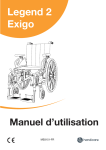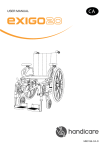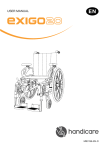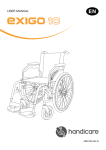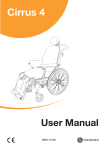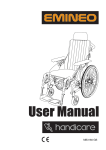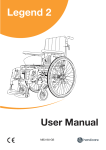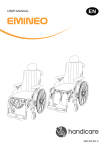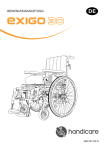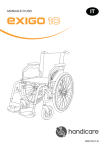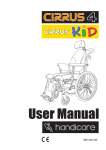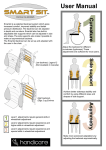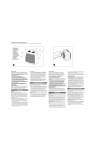Download User manual Legend 2 Exigo
Transcript
Legend 2 Exigo User Manual MB3151-GB Introduction Congratulations on your choice of new wheelchair. Quality and functionality are keywords for all Handicare wheelchairs. Legend 2 Exigo is manufactured by Handicare AS. For your own safety, and in order to get the greatest benefit from the features of your new wheelchair, we recommend that you read this user manual carefully before you start to use the wheelchair. About Handicare Legend 2 Exigo Legend 2 Exigo has been developed in collaboration with the market. The result is a unique wheelchair that is very comfortable and has good rolling characteristics. A total width only 18 cm greater than the seat width provides good accessibility through narrow doors and in tight spaces. Legend 2 Exigo is easy to transport in a car or in other vehicles; the chair is only 30 cm wide when folded. Legend 2 Exigo can be easily adapted to the needs of each user. A wide range of adjustments can be made, and the procedures used are intuitive and require minimal use of tools or replacement of parts. Intended use Legend 2 Exigo is designed for both indoor and outdoor use. This wheelchair has been developed for persons with disabilities and as an aid for those who have problems with walking. Users who can control the wheelchair by rolling, steering and braking it themselves can use the wheelchair without an assistant. This user manual accompanies Legend 2 Exigo with serial number:. . . . . . . . . . . . . . . . . . . . . . . . . . . . . . . . . . . . . . . The product has been checked and approved on: . . . . . . . . . . . . . . . . . . . . . . . . . . . . . . . . . . . . . . . . . . . . . . . . . . . . by: . . . . . . . . . . . . . . . . . . . . . . . . . . . . . . . . . . . . . . . . . . . . . . . . . . . . Handicare AS www.Handicare.com 2 MB3151-GB Contents Introduction...................................................................................2 Contents ........................................................................................3 Parts of the wheelchair ................................................................4 Assembly and transport ..............................................................5 Using the wheelchair....................................................................6 Adjusting the wheelchair ...........................................................11 Fitting a positioning belt ............................................................18 Safety ...........................................................................................19 Maintenance ................................................................................20 Technical specifications ............................................................24 Labelling ......................................................................................25 Accessories ................................................................................26 Guarantee ....................................................................................28 Notes............................................................................................29 MB3151-GB 3 Parts of the wheelchair In order to be able to read and understand this manual it is important that you familiarise yourself with the most common terms that we use for the different parts of the wheelchair. Have a look at figure 1 and note the relevant parts on your wheelchair. The equipment on your wheelchair may vary slightly from the figure shown. 8 1 2 3 4 12 5 6 11 10 13 14 Figure 1 Backrest with backrest cover 2 3 4 5 Armrests 4 15 7 1 Seat 6 7 8 9 Leg support 10 Hand rim Clothing guards 9 Frame 11 Brake Footplate 12 Wheel block Pushing handle 13 front castor wheel 14 Front castor wheel fork Driving wheels Bearing housing for 15 Front castor wheel MB3151-GB Assembly and transport Assembly Figure 2 The wheelchair is supplied complete as standard. The only thing you need to do is to unfold the chair and, if necessary, fit the leg supports. Figure 2 Unfolding the wheelchair Figure 3 Unfold the wheelchair by pushing down with flat hands on the upholstery next to the seat tubing. NB: Do not grasp the seat tubing – you may catch your fingers! Put the seat cushion (accessory) in position and ensure that it lies correctly on the seat fabric. Figure 3 Folding up the wheelchair Figure 4 Remove the seat cushion (accessory) and fold up the footplates or remove the leg supports before you fold up the wheelchair. Grasp the seat fabric and lift it directly upwards. The seat will fold itself up. Make sure that the backrest fabric folds itself backwards. Figure 4 MB3151-GB 5 Using the wheelchair Quick-release hub Figure 5 The wheelchair has a quick-release hub on each of the driving wheels. Depress the button in the centre of the driving wheel to remove or replace the wheel. NB: Check that the wheel is properly fastened by making sure that the button pops out about 5 mm when the wheel bolt is fully in the casing. Figure 5 Height-adjustable pushing handles Figure 6 The pushing handles can be adjusted by releasing the locking handle while simultaneously pulling the pushing handle upwards or downwards to the desired height. Then tighten the locking handle again. You can remove the pushing handles completely by releasing the locking handle, pressing in the sprung plug (6A) and pulling up on the pushing handles. A Figure 6 Armrests, swing-up Figure 7 • Press the release button and pull up the armrest Ensure that the armrest locks into position when you swing it back down. Figure 7 6 MB3151-GB Using the wheelchair Adjusting the height of the armrests Figure 8 • Press the release button (A) and raise or lower the armrest. A Figure 8 Swinging out/fitting/removing the leg supports Figures 9 and 10 The leg supports can be swung in and out or removed to make transfers easier. The leg support is released by turning the handle (9A) inwards or outwards while swinging the leg support. A Figure 9 Once the leg support has been swung to the side, it can be lifted up and removed completely if desired. To replace it, follow the above procedure in the reverse order. The handle will automatically lock itself. Figure 10 MB3151-GB 7 Using the wheelchair Using the brakes Figure 11 Pull the brake lever towards you to lock the brake. The brakes are only designed to keep the chair stationary. Under no circumstances must they be used as a driving brake. Figure 11 Anti-tip stabiliser Figure 12 The anti-tip stabiliser is deployed by pulling it out while simultaneously turning it down. The anti-tip stabiliser is adjusted as standard with a clearance to the floor which makes it possible to negotiate door sills and similar. Figure 12 8 MB3151-GB Using the wheelchair Transferring into and out of the chair Figures 13, 14 and 15 • Engage the brakes • Swing the leg supports out if necessary • Move yourself to the front of the chair before transferring to another chair, bed, etc. Figure 13 Figure 14 Figure 15 MB3151-GB 9 Using the wheelchair Negotiating obstacles: steps Figures 16 and 17 If the wheelchair is to be lifted up or down steps with the user in the chair, if possible use the recommended lifting points. The lifting points are the pushing handles and leg supports. Figure 16 In order for the assistants to have a better lifting position, they may lift one on each side of the chair. Negotiating obstacles: kerbstones Figure 18 When negotiating kerbstones or similar, swing up the anti-tip stabiliser. Then place a foot on the tipping bar while you simultaneously push with the pushing handles. Figure 17 Steep ground If you frequently use the wheelchair on hilly surfaces, we recommend that a separate assistant brake be installed. Figure 18 10 MB3151-GB Adjusting the wheelchair Adjusting the seat height The seat height can easily be adjusted. You can also change the angle of the seat by having a different seat height front and back. By changing the seat angle, you can achieve better stability and sitting comfort. The various methods of adjusting the seat height also have an effect on the wheelchair’s manoeuvrability and rolling characteristics. Figure 19 Adjusting the height of the back of the seat Figures 19 and 20 You can adjust the height of the back of the seat using any of the methods described below. Move the wheel blocks up or down If you move the wheel blocks up, you lower the seat height. If you move the wheel blocks down, you raise the seat height (see page 16). Change to larger or smaller driving wheels Using larger driving wheels raises the seat height, whereas smaller driving wheels lower the seat height. MB3151-GB Figure 20 11 Adjusting the wheelchair Adjusting the height of the front of the seat Figure 21 You can adjust the height of the front of the seat using any of the methods described below. Move the front castor wheel to a higher or lower position in the castor fork By moving the castor wheel to a higher position in the castor fork (21A) you lower the seat height; by moving the castor wheel to a lower position you raise the seat height. Front castor wheel fork Bearing housing A Front castor wheel Figure 21 Change to larger or smaller castor wheels Using a smaller castor wheel lowers the seat height, whereas a larger castor wheel will raise the seat height. If you change the castor wheels to a smaller model, this will reduce the turning circle and thereby make it easier to negotiate tight spaces. It will also provide more room for your legs. On the other hand, using larger castor wheels will increase the turning circle but will make it easier to negotiate uneven surfaces. Change to a longer or shorter front castor wheel fork A shorter castor wheel fork will lower the seat height, reduce the turning circle and make it easier to negotiate tight spaces. It will also provide more room for your legs. A longer castor wheel fork will raise the seat height and will also give you the option of changing to a wider range of castor wheels. NB: Remember to adjust the angle of the castor wheel when you have changed the seat height; you should also adjust the brakes when you have adjusted the seat height at the back. 12 MB3151-GB Adjusting the wheelchair Adjusting the height of the back of the seat Figures 22 and 25 The height of the back of the seat can be raised or lowered by moving the wheel block up or down in the frame. • Undo the screws (22A) • Move the wheel block up if you wish to lower the seat height A • Move the wheel block down if you wish to raise the seat height • Retighten the screws Figure 22 Adjusting the centre of gravity B Figure 23 If you want the wheelchair to run more freely, you can move the driving wheels forwards. If you want the wheelchair to be more stable and less likely to tip, you can move the driving wheels back. • Loosen the fastening nut (23A) on the wheel a few turns, twist the casing (23B) through 90° and move the wheel to the desired hole A Figure 23 • Twist the adapter back 90° and retighten the fastening nut well NB: Remember to adjust the brakes MB3151-GB 13 Adjusting the wheelchair Adjusting the height of the front of the seat Figures 24 and 25 When adjusting the height of the seat, you should adjust the height of the front castor wheels before you adjust the angle. Move to another position in the castor wheel fork Figure 24 • Undo the screw in the hub of the castor wheel fork • Move the wheel up or down • Retighten the screw Figure 24 Adjusting the angle of the front castor wheel Figure 25 • Undo the screw (25A) a little • Undo the screw (25B) • Insert the Allen key into the turning wheel (25C) and turn it to the desired angle (see the scale) • Tighten the screw (25B). Thread lock, such as Loctite Blue No. 243, may be used. Then tighten the screw (25A) C B A Figure 25 If the front castor wheel is at the correct angle, the bearing housing will be vertical and at 90° to the floor. You can achieve this by using a right angle or set square against the bearing housing and floor. 14 MB3151-GB Adjusting the wheelchair Adjusting the height of the backrest Figure 26 The wheelchair is equipped as standard with a height-adjustable backrest. A The height is adjusted by undoing and removing the fastening screws (26A) on the backrest tubing and then pulling the tubing to the correct height. Then adjust the Velcro adjustment and backrest cover. NB: When making this adjustment you must apply thread lock, such as Loctite Blue No. 253, to all screwed connections. Figure 26 Adjusting the brakes Figures 27 and 28 The wheelchair is delivered as standard with brakes which are adjusted to the middle driving-wheel position. To move the brakes, undo the screw (27A) located on the inside of the frame at the front of the chair. Move the entire brake assembly along the track to the desired position. The correct distance between the brake block and the wheel (28A) is about 2.5 cm. A Figure 27 It should not normally be necessary to adjust the brakes from the position in which they are delivered. A Figure 28 MB3151-GB 15 Adjusting the wheelchair Adjusting the anti-tip stabiliser Figure 29 You should adjust the anti-tip stabiliser when you have changed the centre of gravity of the chair. • Undo the screws (29A). Push or pull the anti-tip stabiliser to the correct position • There should be a maximum of 25 mm from the end of the anti-tip stabiliser to the floor A • Retighten the screws Figure 29 B Adjusting the length of the leg supports Figure 30 The leg supports have a graduated scale (30A) on the outside which will help you to get the correct length. Adjust the length of the leg supports by unscrewing the fastening screws (30B) about 5 mm. Then adjust the leg supports to the desired length and retighten the screws. A Figure 30 Adjusting the angle of the leg supports Figure 31 A The angle of the leg supports can be set to 70˚, 80˚ or 90˚. • Undo the screw (31A) • Push or pull the leg support to the desired angle • Insert the screw into the correct hole and tighten 70º 80º 90º Figure 31 16 MB3151-GB Adjusting the wheelchair Adjusting the seat depth Figure 32 You can adjust the seat depth by up to 5 cm by moving the seat fabric forwards or backwards. • Loosen the seat fabric • Pull the seat fabric forwards to lengthen the seat or backwards to shorten it • Fasten the seat fabric again Figure 32 MB3151-GB 17 Fitting a positioning belt Fitting a positioning belt (accessory) Figures 33, 34 and 35 • Undo the screws (33A) A Figure 33 • Locate the fastening brackets as shown in figure 34. Attach them with the screws you removed, or use the screws that came with the fastening brackets • ................... Feed the positioning belt through the slots in the fastening brackets 18 Figure 34 MB3151-GB Safety • Do not stand on or exert great pressure on the footplates. • A wheelchair should be considered as a replacement for walking. Users must therefore move among pedestrians and not on trafficked roadways. • When you wish to transfer out of the chair, ensure that you are on as stable and even a surface as possible. In order to ensure that the chair does not move, make sure that the brake is in the locked position. • Legend 2 Exigo must not be used as a passenger seat in a vehicle. The wheelchair user must be transferred to the vehicle’s passenger seat and must use the vehicle’s safety belt. • The maximum weight capacity for Legend 2 Exigo is 140 kg. • You should regularly inspect the chair to reassure yourself that all screws, bolts and other fastenings are secure. • The chair should not be used as a seat in motorised vehicles. • When the chair is in use, always ensure that the anti-tip stabiliser is activated. • When any modifications are made to the chair, such as moving the drive wheels, moving the front castor wheels, changing the backrest height, etc., this will affect the chair’s rolling characteristics, balance and tipping point. Therefore, be particularly careful when starting to use the chair again. • It is recommended that a qualified helper be used when transferring into and out of the chair. • Ensure that clothing, bags and other items do not get caught in the wheel spokes. • Be aware of the danger of possible trapping injuries: avoid putting your fingers between the clothing guard and the wheel, and between the wheel and the brake. • If while using the chair it is necessary to raise the front of the chair in order to negotiate an obstruction, never do this by just pressing down on the pushing handles. Tread on the tipping bar while exerting moderate pressure on the pushing handles. • Sitting in a wheelchair for a long period of time increases the danger of pressure sores. If there is a high risk of pressure sores, we recommend the use of special seat cushions to counteract the problem. MB3151-GB 19 Maintenance Maintenance described in this section can be carried out by the user. Other maintenance work should be carried out by qualified personnel at the supplier in your municipality or at the technical aids centre. For information about repairs or servicing, please contact the technical aids centre in your county. Washing the frame The frame should be washed regularly with warm soapy water. If the frame is very dirty, a degreasing agent may be used. The frame may be washed with a high-pressure hose. If you use this method, avoid directly spraying the ball bearings. Dry the wheelchair well after washing it or after it has been used in rainy conditions. If a degreasing agent is used, moving parts should be greased afterwards. Cleaning the seat and backrest covers The upholstery and backrest cover can be washed in a washing machine at 60 °C. See the washing instructions on the various textiles. Conditions which could damage the wheelchair The chair should not be used at temperatures below -35 °C or over 60 °C. No specific requirements are made in connection with humidity or air pressure. No further requirements are made regarding storage conditions. 20 MB3151-GB Maintenance Screws and nuts Screws and nuts can become loose over time. Therefore, remember to check and if necessary retighten all screws and nuts on a regular basis. A thread-locking product, such as Loctite Blue No. 243, may be used. If self-locking nuts have been removed they lose some of their locking ability and should be replaced. Driving wheels The driving wheels are fitted with spokes. These should be checked and adjusted at least once a year. Contact a local bicycle dealership or your nearest technical aids centre. Quick-release hub for wheels The quick-release hub for the driving wheels requires regular inspection. Check that the ball bearings are working satisfactorily. The release bolt and ball bearings should be cleaned and oiled regularly. MB3151-GB 21 Maintenance Recommended pressure The chair is supplied as standard with solid wheels. Find the indication of the size on the driving wheel or castor wheel, and then read off the recommended maximum pressure in the table. Note that a high pressure makes the chair easier to roll, whereas a low pressure gives a smoother ride. For optimal rolling characteristics, the pressure should be checked regularly. kPa Bar PSI Driving wheel, pneumatic 350 3.5 50 Driving wheel, high-pressure 630 6.3 90 Front castor wheel, 6", pneumatic 250 2.5 35 Front castor wheel, 8", pneumatic 250 2.5 35 Inspection after six months, thereafter each year • Check that the brakes function correctly. Adjust if necessary. • Check that the tyres are in good condition and that there has been no damage to the sidewalls. • Ensure that the chair is clean and that all moving parts function correctly. • Check for any slack in the front castor wheel forks, and adjust if necessary (i.e. the axle should run freely around its axis, but there should be no slack up or down). • Check and if necessary adjust all screwed connections. Repairs Apart from small repairs to paintwork, the replacement of tyres and inner tubes, and the adjustment of the brakes, all repairs must be undertaken by qualified personnel at the supplier in your municipality or at the technical aids centre. For information about repairs or servicing, contact the technical aids centre in your county. 22 MB3151-GB Maintenance Replacing pneumatic tyres B Figure 35 Pneumatic tyres are an accessory Removing the tyre • Remove the wheel, then deflate the tyre by depressing the little pin in the valve or unscrewing the valve. • Ensure that the edge of the tyre sits well down in the internal depression of the wheel rim (35A). • Bend the edge of the tyre over the rim. Use a special tyre lever (35B) if necessary. Take care to ensure that the tube does not become pinched between the lever and the rim. C A Figure 35 Fitting the tyre • Put the tube into the new tyre and apply a friction-reducing agent (tyrefitting lubricant or soap) on the edge of the tyre (35C). • Ensure that the edge of the tyre sits well down in the depression of the wheel rim on one side. Bend the tyre over the rim edge. Take care to ensure that the tube does not become pinched. • Inflate to the correct pressure and fit the wheel to the chair. MB3151-GB 23 Technical specifications Technical specifications and measurements The wheelchair is supplied as standard in various different seat heights and seat widths. Which height suits the user of the wheelchair depends on two factors: the height of the individual and how the chair will be used. Consult your dealer or nearest technical aids centre if you are uncertain whether you have the correct height and width. (All measurements are in centimetres unless stated otherwise.) Seat width 36, 39, 42, 45, 48 and 51 cm Seat depth 39 cm (adjustable 39–44 cm) Seat height 36–48 cm Backrest height 42–46 cm Armrest height 22–27 cm Total height 89 cm Transport height 89 cm Total width Seat width + 18 cm Transport width 28 cm Total length 97 cm Transport length 99 cm Weight of chair 15,9 kg Transport weight 10.1 kg Max. user weight 140 kg The wheelchair and most of the parts are manufactured using a special aluminium alloy. The backrest and seat are covered with flame-retardant material. The driving and caster wheels can be supplied with solid or pneumatic tyres as desired. Waste handling Waste relating to packaging, parts of the wheelchair or the wheelchair itself can be treated as general waste. The main component of the wheelchair is aluminium, which can be melted down for reuse. The plastic and cardboard used in the packaging can be recycled. 24 MB3151-GB Labelling Product name Model Seat width Seat depth Max. user weight Serial number CE mark 700 001 Year and month of production Climbing angle MB3151-GB 25 Accessories 1 4 3 2 5 6 8 7 9 12 26 10 11 13 MB3151-GB Accessories Driving wheel and driving wheel fixings Armrests and clothing guards • Armrests with short pads • Amputation blocks • Driving wheels of various dimensions and with different tyres – solid, highpressure and pneumatic tyres • Wheel for single-hand operation • Friction hand rim • Friction cover • Spoke protectors 1 • Assistant brake • Quick-release hub for users with weak hands Front castor wheels and castor fixings • Front castor wheels of various dimensions and with different tyres – solid or pneumatic tyres • Front castor wheel forks, various sizes Leg supports • • • • • Leg support, adjustable-angle Footplate, depth-adjustable 3 Footplate, adjustable-angle Amputation support 4 Plaster-cast leg support 5 Backrest • • • Height-adjustable pushing handles 6 Pushing handle Pushing handle with neck-support fastening Other accessories • • • • • • • • • • • Pump, electric 7 Crutch holder Table 8 Seat cushion, standard 9 Seat cushion, Smartsit Basic 10 Seat cushion, Smartsit Comfort Hip belt 12 Fastening for hip belt Rucksack Seat bag Head and neck support 13 11 2 Fitting instructions are supplied with accessories. Contact your nearest Handicare branch for accessories and spare parts. MB3151-GB 27 Guarantee Guarantee: This guarantee applies to all new Handicare manual wheelchairs sold through authorised Handicare AS dealers. This product is guaranteed for two years from the date of delivery. Handicare AS guarantees that the product will not have any faults with regard to both materials and workmanship, and that it will meet all the requirements specified in the sales brochure. Handicare AS guarantees free repairs and maintenance, as well as replacement of any defective parts, provided that the damage was caused during normal use as described in the user manual. All claims, replacement of parts and service to be covered by the limited guarantee described below must be submitted in writing to Handicare AS within 45 days of the failure in order to be covered by the guarantee. Exclusions and limitations • Equipment that has been adjusted by someone other than Handicare AS or a representative from the technical aids centre is not covered by this guarantee. • Tyres, tubes and upholstery are not covered by this guarantee. • Damage to accessories is not covered by this guarantee. • Equipment which is treated irresponsibly or used in a manner contrary to the guidelines in this user manual will not be covered by the guarantee. Procedure for claims under the guarantee Equipment which proves not to function satisfactorily shall be returned to the authorised Handicare AS dealer from which the equipment was purchased. The dealer will undertake the necessary repairs and service. Handicare AS will endeavour to provide the dealer with the necessary parts to carry out the repair, but the guarantee does not cover carriage of equipment to or from the dealer nor a replacement wheelchair while the customer’s wheelchair is being repaired. If the buyer is unable to return the equipment to the authorised Handicare AS dealer that sold it, the buyer should contact Handicare AS’s head office in Norway (tel. +47 69 24 44 00) in order to obtain the name of an authorised dealer that can undertake the repair under the guarantee. The buyer should have to hand the model number, serial number, purchase date and description of the fault whenever contacting the dealer. 28 MB3151-GB Notes MB3151-GB 29 Notes Warning: The content of this user manual is only intended as information. This information may be changed without warning and must not therefore be interpreted as an obligation on the part of Handicare AS. Handicare AS is not responsible, either legally or financially, for any errors or inaccuracies that may appear in this user manual. All products that are mentioned in this user manual are registered trademarks and cannot be used in other contexts without the consent of Handicare AS. 30 MB3151-GB Notes MB3151-GB 31 03-Utgitt mai 2009 Handicare AS Manufactured by: Handicare AS www.handicare.com
































